Guedelon
A team of enthusiasts is building a 13th century chateau in Burgundy, France from scratch using medieval tools and techniques.
FOR THE BEST EXPERIENCE OPEN IN BROWSER AND TILT YOUR PHONE
FOR THE BEST EXPERIENCE OPEN IN BROWSER AND TILT YOUR PHONE
This website uses cookies to ensure you get the best experience.
Here are the Terms of Use and Privacy Policy
Here are the Terms of Use and Privacy Policy
OK

Maryline Martin, Guedelon’s co-founder and CEO
Imagine building a castle according to the 13th century techniques! This is exactly what a team of enthusiasts is doing right now next to an old quarry in Burgundy, France. Actually, they have been building their Chateau de Guedelon - absolutely from scratch - for the last 20 years or so. Artiom Ganin of @Castles_and_Palaces has virtually sat down with Maryline Martin, Guedelon's co-founder and CEO, to talk about the project which is unprecedented in terms of its scale and significance. The team uses medieval tools and applies the medieval technology. Maryline says it is a great example of the so-called experimental archaeology on a massive scale as they seek to better understand the work of medieval master-builders.
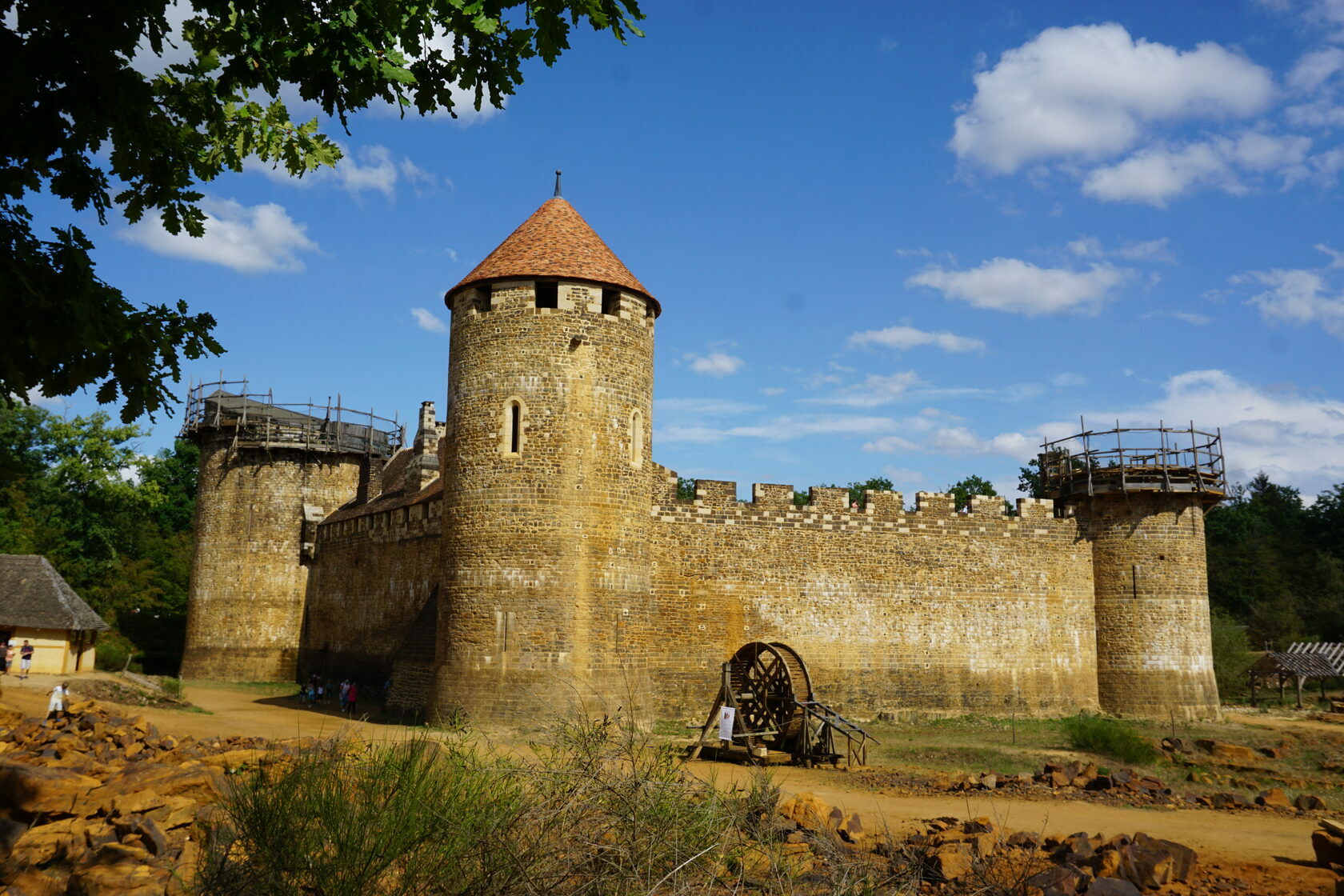
©Guédelon
WHY THE 13TH CENTURY CASTLE?
Castles_and_Palaces (CnP): Maryline, please tell me a few words about yourself and your family.
Maryline Martin (MM): I was born and grew up in this part of rural France. After studying oriental languages, I worked for a major export/import company in Brussels and then Paris. After the birth of my daughter it felt natural to return to the woods and lakes of northern Burgundy.
Maryline Martin (MM): I was born and grew up in this part of rural France. After studying oriental languages, I worked for a major export/import company in Brussels and then Paris. After the birth of my daughter it felt natural to return to the woods and lakes of northern Burgundy.
CnP: So, you want to get a newly-built 13th century castle – why exactly this period, what is so special about it?
MM: The early 13th century is an incredibly inspiring period in history. In northern Europe, it is a period of peace and prosperity. The climate was clement; summers were long, winters were mild, harvests were plentiful. Hydraulic power was being harnessed, more corn could be ground to feed a growing population. This industrial revolution freed up the population to build cathedrals ever higher! It was a golden age for castle-construction.
MM: The early 13th century is an incredibly inspiring period in history. In northern Europe, it is a period of peace and prosperity. The climate was clement; summers were long, winters were mild, harvests were plentiful. Hydraulic power was being harnessed, more corn could be ground to feed a growing population. This industrial revolution freed up the population to build cathedrals ever higher! It was a golden age for castle-construction.

©Guédelon
CnP: Why is the castle named Guedelon?
MM: Guedelon is the name of the forest which surrounds our quarry and the name of the near-by lake. The name goes back to at least the 15th century. It felt like an obvious choice for our castle.
CnP: So you discovered the old foundations and it was the starting point. You launched the works – what was the key for choosing the location for your castle?
MM: No, in fact Guedelon is a new-build. We are building the castle from scratch using medieval tools and medieval technology. It is experimental archaeology on a massive scale. We are seeking to better understand the work of medieval master-builders by building as they would have done.
MM: Guedelon is the name of the forest which surrounds our quarry and the name of the near-by lake. The name goes back to at least the 15th century. It felt like an obvious choice for our castle.
CnP: So you discovered the old foundations and it was the starting point. You launched the works – what was the key for choosing the location for your castle?
MM: No, in fact Guedelon is a new-build. We are building the castle from scratch using medieval tools and medieval technology. It is experimental archaeology on a massive scale. We are seeking to better understand the work of medieval master-builders by building as they would have done.

©Guédelon
CnP: Which authentic tools does your team use in this building experiment?
MM: The tools we use on site are based on medieval iconography. Many are completely unchanged since the Middle Ages. If a tool worked hundreds of years ago, why would it change?
MM: The tools we use on site are based on medieval iconography. Many are completely unchanged since the Middle Ages. If a tool worked hundreds of years ago, why would it change?
A castle with the 17th century paintings of scenes from the Greek mythology?
We are building the castle from scratch using medieval tools and medieval technology
CnP: What's the building material and where do you get it from?
MM: Just as a bird gathers material to build its nest, we are gathering stones from the quarry, oak from the woodland, clay from the forest floor, burning limestone offcuts, smelting iron ore…in order to transform the local environment into a fortress.
MM: Just as a bird gathers material to build its nest, we are gathering stones from the quarry, oak from the woodland, clay from the forest floor, burning limestone offcuts, smelting iron ore…in order to transform the local environment into a fortress.

©Guédelon
CnP: Which difficulties do you have and what's the biggest challenge?
MM: The first challenge we faced was learning how to extract the ferruginous sandstone from the quarry. We knew from archaeology that a system of wedges was used, but learning to master the technique took time. In the early days, we genuinely wondered if the project was feasible. We simply couldn't extract enough stone for the masons; now, the quarrymen make splitting a block look like child's play, but it took years to learn how to "read" the stone. Anyone who works with their hands has to first work with their head!
MM: The first challenge we faced was learning how to extract the ferruginous sandstone from the quarry. We knew from archaeology that a system of wedges was used, but learning to master the technique took time. In the early days, we genuinely wondered if the project was feasible. We simply couldn't extract enough stone for the masons; now, the quarrymen make splitting a block look like child's play, but it took years to learn how to "read" the stone. Anyone who works with their hands has to first work with their head!
CnP: One thing is to read about the techniques of the past and apply them here or there during restoration works. But using these techniques on a grand scale – like you do – is a totally different thing. Tell me about the medieval technology – what are the peculiarities?
MM: Guedelon has taught me that there is no end to human ingenuity. Medieval technology relies above all on common sense.
MM: Guedelon has taught me that there is no end to human ingenuity. Medieval technology relies above all on common sense.

©Guédelon
TECHNIQUES ARE OLD BUT SAFETY STANDARDS ARE UP-TO-DATE
CnP: Well, some medieval masons used to brick up young ladies inside the walls of castles under construction to reinforce them (especially when bricks or stones wouldn't stick together well) – I hope you are not applying this kind of techniques?
MM: These are exactly the kind of myths which we are seeking to overturn! We work with a team of archaeologists to best understand the formulations used to bind the stones or how to fix the stones to build a strong wall. We chemically analysed lime mortar from neighbouring medieval castles in order to find the correct formulation for mortar made in this region.
MM: These are exactly the kind of myths which we are seeking to overturn! We work with a team of archaeologists to best understand the formulations used to bind the stones or how to fix the stones to build a strong wall. We chemically analysed lime mortar from neighbouring medieval castles in order to find the correct formulation for mortar made in this region.
now, the quarrymen make splitting a block look like child's play, but it took years to learn how to "read" the stone
CnP: How many people are involved in the project? Who are they?
MM: There are 40 people who are directly involved in the castle-construction. Some have always lived in this area, some have travelled from across the world to participate in the venture. We have had workers from as far afield as New Zealand and Canada.
MM: There are 40 people who are directly involved in the castle-construction. Some have always lived in this area, some have travelled from across the world to participate in the venture. We have had workers from as far afield as New Zealand and Canada.
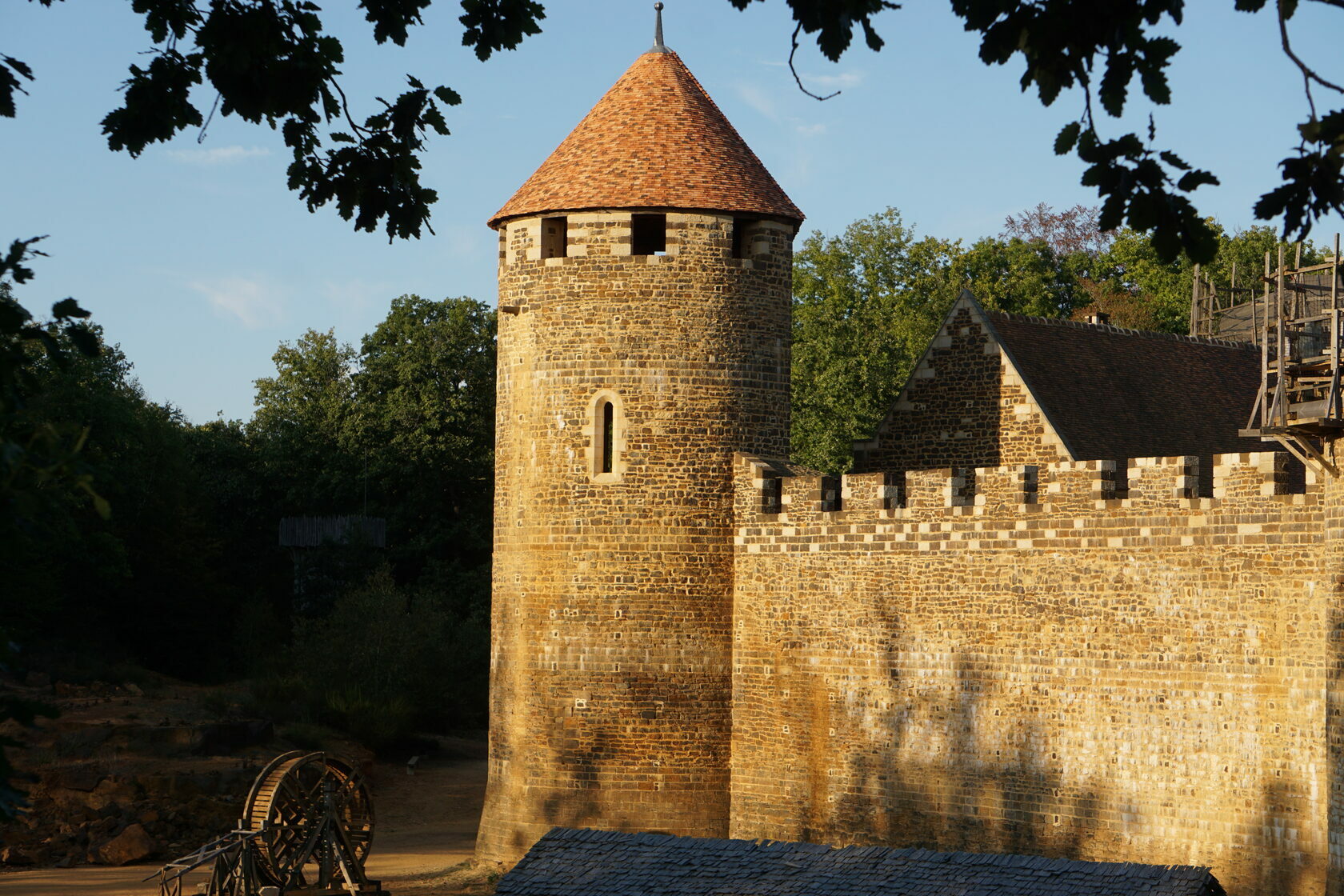
©Guédelon
CnP: What about health and safety requirements. The 13th century masons surely had no helmets on during construction works – is there a compromise?
MM: The Health and Safety of our staff and visitors is of utmost importance and is the one limit which we impose on ourselves. The workers on site have safety equipment: steel toe-capped boots, protective eyewear, helmets when working under scaffolding etc. The wooden putlog scaffolding is reinforced with additional braces and have safety barriers attached. Safety regulations were clearly nothing like today; however, there were still rules in place to try and protect these highly trained, respected craftsmen.
MM: The Health and Safety of our staff and visitors is of utmost importance and is the one limit which we impose on ourselves. The workers on site have safety equipment: steel toe-capped boots, protective eyewear, helmets when working under scaffolding etc. The wooden putlog scaffolding is reinforced with additional braces and have safety barriers attached. Safety regulations were clearly nothing like today; however, there were still rules in place to try and protect these highly trained, respected craftsmen.

©Guédelon
CnP: What's your philosophy behind this unusual project?
MM: Before Guedelon, I founded an association working with the long-term unemployed maintaining rivers and woodlands. Guedelon represented an opportunity to create long-term jobs and real training. Beyond that, my philosophy at Guedelon would be the right to "fail better". We are building in order to better understand medieval construction; along the way, we stumble, make mistakes, question our ways of working, but each "mistake" brings us closer to our goal. The right to "fail" is unheard of in our society today.
MM: Before Guedelon, I founded an association working with the long-term unemployed maintaining rivers and woodlands. Guedelon represented an opportunity to create long-term jobs and real training. Beyond that, my philosophy at Guedelon would be the right to "fail better". We are building in order to better understand medieval construction; along the way, we stumble, make mistakes, question our ways of working, but each "mistake" brings us closer to our goal. The right to "fail" is unheard of in our society today.
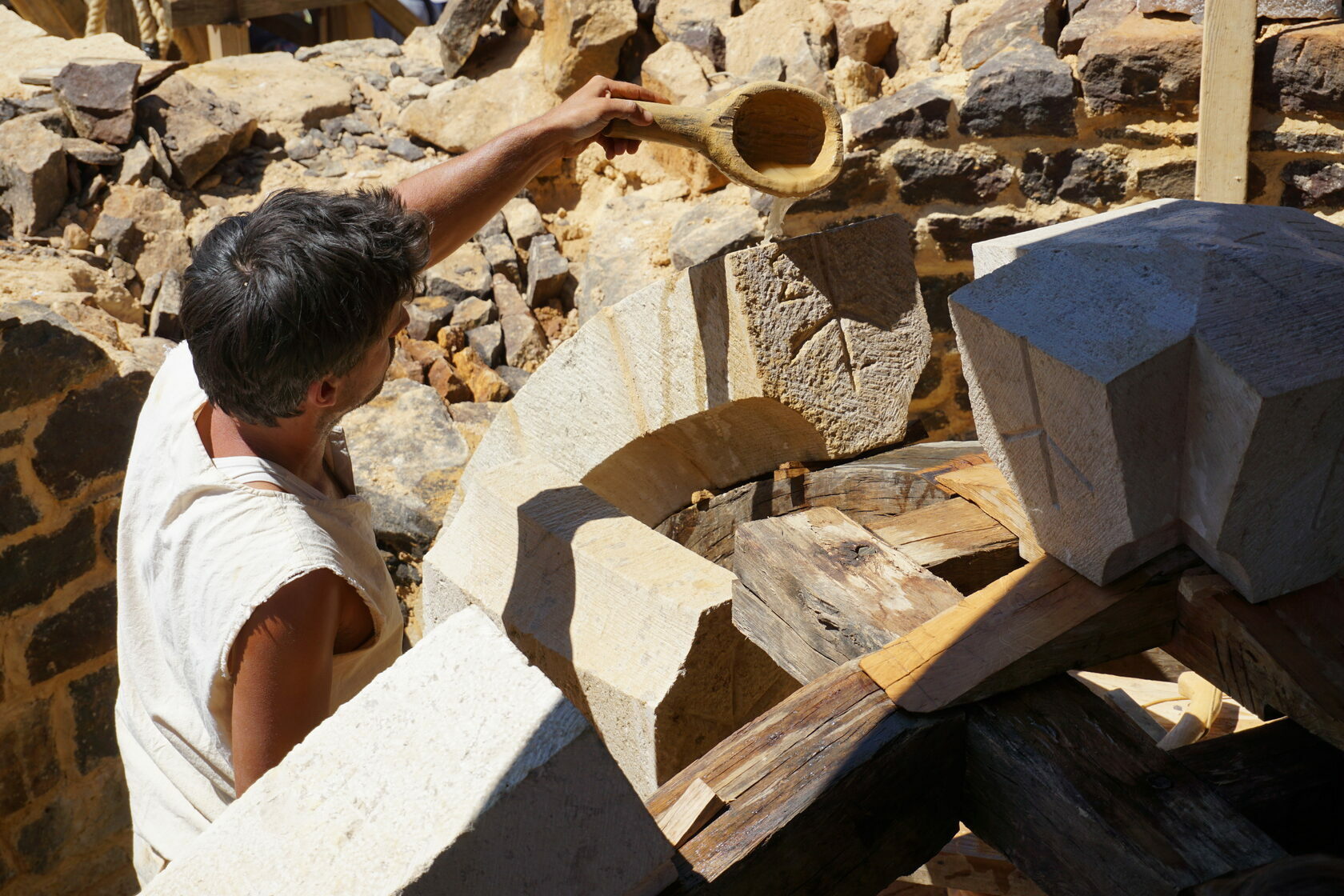
©Guédelon
WHY NOT BUILD FASTER?
CnP: What does a typical medieval castle builder's day look like?
MM: Of course, each day is different depending on the craft in question. For the stonemasons, the day will begin mixing up a batch of lime mortar. The carters will then come and help transport the mortar in the tipping cart to the base of the treadwheel winch. The stonemasons operate the winch by walking in the wooden drums. They can hoist up to 500 kg at a time. This medieval crane is used to hoist mortar, stones and can also be used to hoist timber for the roofs and scaffolding. The stonemasons are the forgotten heroes of medieval construction. We tend to admire the sculpture, the stained glass windows…but without the builders, there would be no Notre-Dame to admire, to Mont-Saint-Michel. The builders at Guedelon work on building the 2-metre-thick walls, cross-ribbed vaults, gothic windows…An important part of their work at Guedelon is transmitting their knowledge. At least half of the working day is dedicated to explaining their work to the visitors. We also welcome young trainee stonemasons who will go on to work on restoring historic monuments throughout Europe.
MM: Of course, each day is different depending on the craft in question. For the stonemasons, the day will begin mixing up a batch of lime mortar. The carters will then come and help transport the mortar in the tipping cart to the base of the treadwheel winch. The stonemasons operate the winch by walking in the wooden drums. They can hoist up to 500 kg at a time. This medieval crane is used to hoist mortar, stones and can also be used to hoist timber for the roofs and scaffolding. The stonemasons are the forgotten heroes of medieval construction. We tend to admire the sculpture, the stained glass windows…but without the builders, there would be no Notre-Dame to admire, to Mont-Saint-Michel. The builders at Guedelon work on building the 2-metre-thick walls, cross-ribbed vaults, gothic windows…An important part of their work at Guedelon is transmitting their knowledge. At least half of the working day is dedicated to explaining their work to the visitors. We also welcome young trainee stonemasons who will go on to work on restoring historic monuments throughout Europe.
Our aim is to explain our work to the greatest number possible, not to finish the castle as quickly as possible
Highgarden, House Tyrell - this castle featured in HBO's GOT series
CnP: How many attempts were made by other enthusiasts to recreate a castle from scratch in the past?
MM: We were visited by a gentleman who has rebuilt a Italian medieval castle in the Napa Valley! Guedelon is a unique venture in that we are using medieval building techniques to build our castle. We will no doubt inspire other similar projects.
MM: We were visited by a gentleman who has rebuilt a Italian medieval castle in the Napa Valley! Guedelon is a unique venture in that we are using medieval building techniques to build our castle. We will no doubt inspire other similar projects.

©Guédelon
CnP: You started back in the 1998 but the construction is scheduled to finish only in 2023 (or 2030 – different sources say different things). Why is it taking so long?
MM: It was an act of provocation, back in 1997, when we announced that we were going to build a castle from scratch and that it would take 25 years to complete. In this age, when everything has to be faster, quicker…we were going to take as much time as was needed: to learn, to stumble, to question, to "fail better". In the early 13th century, a castle such as Guedelon would have been finished in 12-15 years. A royal castle, for example the medieval Louvre, was built in 10 years; Richard Lionheart built Chateau Gaillard in an amazing two years! We are taking much longer than our medieval counterparts because we don't have their experience and because we welcome 300,000 visitors to the site each year. Our aim is to explain our work to the greatest number possible, not to finish the castle as quickly as possible.
MM: It was an act of provocation, back in 1997, when we announced that we were going to build a castle from scratch and that it would take 25 years to complete. In this age, when everything has to be faster, quicker…we were going to take as much time as was needed: to learn, to stumble, to question, to "fail better". In the early 13th century, a castle such as Guedelon would have been finished in 12-15 years. A royal castle, for example the medieval Louvre, was built in 10 years; Richard Lionheart built Chateau Gaillard in an amazing two years! We are taking much longer than our medieval counterparts because we don't have their experience and because we welcome 300,000 visitors to the site each year. Our aim is to explain our work to the greatest number possible, not to finish the castle as quickly as possible.

©Guédelon
CnP: Aren't you sick and tired of building this castle for the last 20+ years? You don't want to abandon the project, do you?
MM: Not at all! Each new season is a new chapter with new challenges, whether that be hewing oak for timber-frame roof, bringing a cross-ribbed vault under load or experimenting with making waxcloth windows.
MM: Not at all! Each new season is a new chapter with new challenges, whether that be hewing oak for timber-frame roof, bringing a cross-ribbed vault under load or experimenting with making waxcloth windows.
CnP: So what is the plan – how will the castle look once it is completed?
MM: The castle is based on the style of castle built in the French kingdom in the late 12th to 13th century. It was a standard plan employed by the French king, Philip Augustus: a quadrangular ground plan, ranges built against the curtain walls, four cylindrical flanking towers, a twin-towered gatehouse, surrounded by a deep dry-ditch.
MM: The castle is based on the style of castle built in the French kingdom in the late 12th to 13th century. It was a standard plan employed by the French king, Philip Augustus: a quadrangular ground plan, ranges built against the curtain walls, four cylindrical flanking towers, a twin-towered gatehouse, surrounded by a deep dry-ditch.

©Guédelon
CnP: Will it be a museum or maybe a hotel with a restaurant?
MM: Once the castle is completed visitors will be able to experience walking around a castle exactly as it would have been in the early 13th century. It will be the only castle in the world for which there will be documentary evidence for each stage of the construction process. Through the thousands of photos, films and interviews we have amassed it will be possible to "deconstruct" the castle.
CnP: What about the interiors?
MM: Contrary to popular belief – thank you Hollywood! – medieval castles did not have bare-stone walls. The interiors were lime-rendered and limewashed. The higher-status chambers were decorated with mural paintings. This season, visitors will be able to witness the painting of the castle's chapel. The palette of colours is made from pigments produced on site.
MM: Once the castle is completed visitors will be able to experience walking around a castle exactly as it would have been in the early 13th century. It will be the only castle in the world for which there will be documentary evidence for each stage of the construction process. Through the thousands of photos, films and interviews we have amassed it will be possible to "deconstruct" the castle.
CnP: What about the interiors?
MM: Contrary to popular belief – thank you Hollywood! – medieval castles did not have bare-stone walls. The interiors were lime-rendered and limewashed. The higher-status chambers were decorated with mural paintings. This season, visitors will be able to witness the painting of the castle's chapel. The palette of colours is made from pigments produced on site.
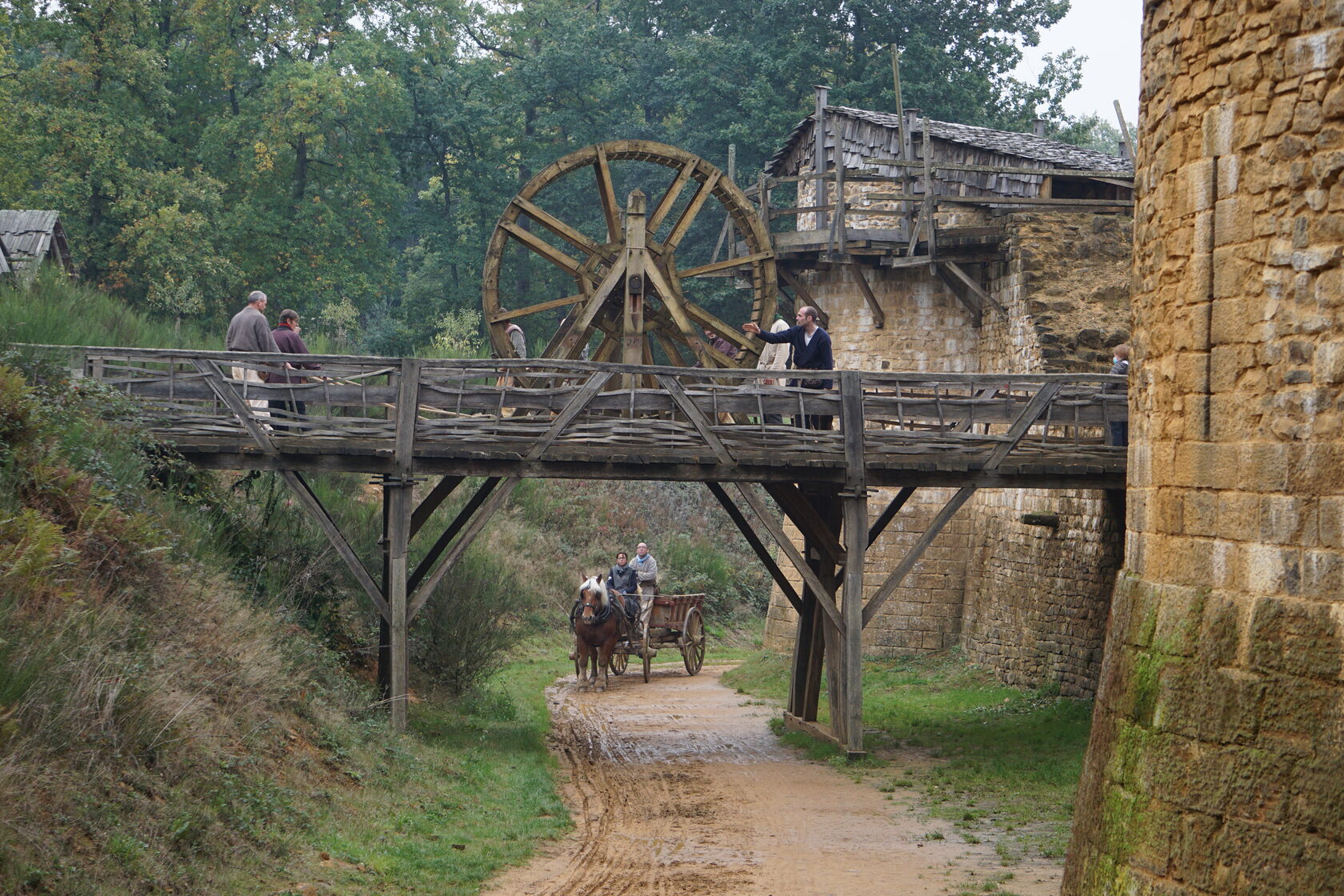
©Guédelon
CnP: Tell me what have you learnt during the works about the medieval times?
MM: We have learnt so much, from how to quarry stone to the role of women in the Middle Ages. We have learnt that there isn't one "Middle Ages": this period lasted for a thousand years. The 13th century, far from being a dark, uncivilized time, the Middle Ages was full of colour. It was a time of technological and architectural progress.
CnP: What is the most inspiring thing for you?
MM: The fact that nature can provide everything we need to build. When we first started building, we never imagined that this abandoned quarry would provide so many treasures, that we would be able to smelt iron, make 15 different colours…
MM: We have learnt so much, from how to quarry stone to the role of women in the Middle Ages. We have learnt that there isn't one "Middle Ages": this period lasted for a thousand years. The 13th century, far from being a dark, uncivilized time, the Middle Ages was full of colour. It was a time of technological and architectural progress.
CnP: What is the most inspiring thing for you?
MM: The fact that nature can provide everything we need to build. When we first started building, we never imagined that this abandoned quarry would provide so many treasures, that we would be able to smelt iron, make 15 different colours…

©Guédelon
CnP: How did the COVID pandemic affect the construction works?
MM: Our 2020 season was shortened by several months and it looks like the same will be true for 2021. Like everyone, we have had to adapt. Most of the site is in the open-air and there has always been a natural distance between the visitors and the craftsmen in their workshops. Last year has taught us that during the pandemic we can safely welcome thousands of visitors and we look forward to being able to do so again soon.
MM: Our 2020 season was shortened by several months and it looks like the same will be true for 2021. Like everyone, we have had to adapt. Most of the site is in the open-air and there has always been a natural distance between the visitors and the craftsmen in their workshops. Last year has taught us that during the pandemic we can safely welcome thousands of visitors and we look forward to being able to do so again soon.
A unique Tuscan castle hotel on the Condè Nast Traveler's Gold List 2019
CnP: Back in the 1990s you raised some 400,000 euros for the project – where do you get the money now?
MM: Guedelon is entirely self-financed through ticket sales, the restaurants and gift shop. Our 300,000 visitors a year finance this unique venture.
MM: Guedelon is entirely self-financed through ticket sales, the restaurants and gift shop. Our 300,000 visitors a year finance this unique venture.

©Guédelon
CnP: How much have you already spent and how much more are you going to spend in the future – if it is not a secret?
MM: Guedelon has an annual turnover of over €5M. Our investment is in the people who work here, most of the materials can be found on site.
CnP: What do the locals think about your undertaking?
MM: The locals were perhaps the hardest to convince that Guedelon was a viable project, but now the positive impact on the local economy is clear to see. In a typical season, Guedelon provides jobs, supports local business and draws in 300,000 visitors from all over the world.
MM: Guedelon has an annual turnover of over €5M. Our investment is in the people who work here, most of the materials can be found on site.
CnP: What do the locals think about your undertaking?
MM: The locals were perhaps the hardest to convince that Guedelon was a viable project, but now the positive impact on the local economy is clear to see. In a typical season, Guedelon provides jobs, supports local business and draws in 300,000 visitors from all over the world.

©Guédelon
CnP: And what do architects and cultural heritage people think?
MM: We have had to work hard to gain the respect of the world of culture in France. People were very suspicious initially: "what's the point of building another castle?". And in France, heritage and culture is too often elitist. We weren't specialists, just enthusiasts.
CnP: Do the authorities help you in a way to carry on with the project?
MM: Guedelon is entirely self-financed through ticket sales, the restaurants and gift shop.
MM: We have had to work hard to gain the respect of the world of culture in France. People were very suspicious initially: "what's the point of building another castle?". And in France, heritage and culture is too often elitist. We weren't specialists, just enthusiasts.
CnP: Do the authorities help you in a way to carry on with the project?
MM: Guedelon is entirely self-financed through ticket sales, the restaurants and gift shop.

©Guédelon
CnP: Have you already spent a night at your new castle?
MM: No, but we are lucky to spend time in this incredible space after our visitors have gone home. I love watching how quickly nature reclaims the site once the site has emptied. Owls nest in the castle walls, bats are in the towers, swallows fill the courtyard every summer…
MM: No, but we are lucky to spend time in this incredible space after our visitors have gone home. I love watching how quickly nature reclaims the site once the site has emptied. Owls nest in the castle walls, bats are in the towers, swallows fill the courtyard every summer…
CnP: Which part of the castle you love most of all (out of what is completed now)
MM: The castle is always changing and each new feature is a feat in itself. One of my favourite places is the roof structure on top of the Chapel Tower.
MM: The castle is always changing and each new feature is a feat in itself. One of my favourite places is the roof structure on top of the Chapel Tower.

©Guédelon
CnP: Which area of the castle will you reside once it is completed?
MM: Guedelon is not being built as a private residence. I'll never here, but I live very close by.
CnP: Every castle needs legends and sometimes ghosts – tell me what will be the legends of Chateau de Guedelon?
MM: We're building the castle. Other people will write the legends!
MM: Guedelon is not being built as a private residence. I'll never here, but I live very close by.
CnP: Every castle needs legends and sometimes ghosts – tell me what will be the legends of Chateau de Guedelon?
MM: We're building the castle. Other people will write the legends!
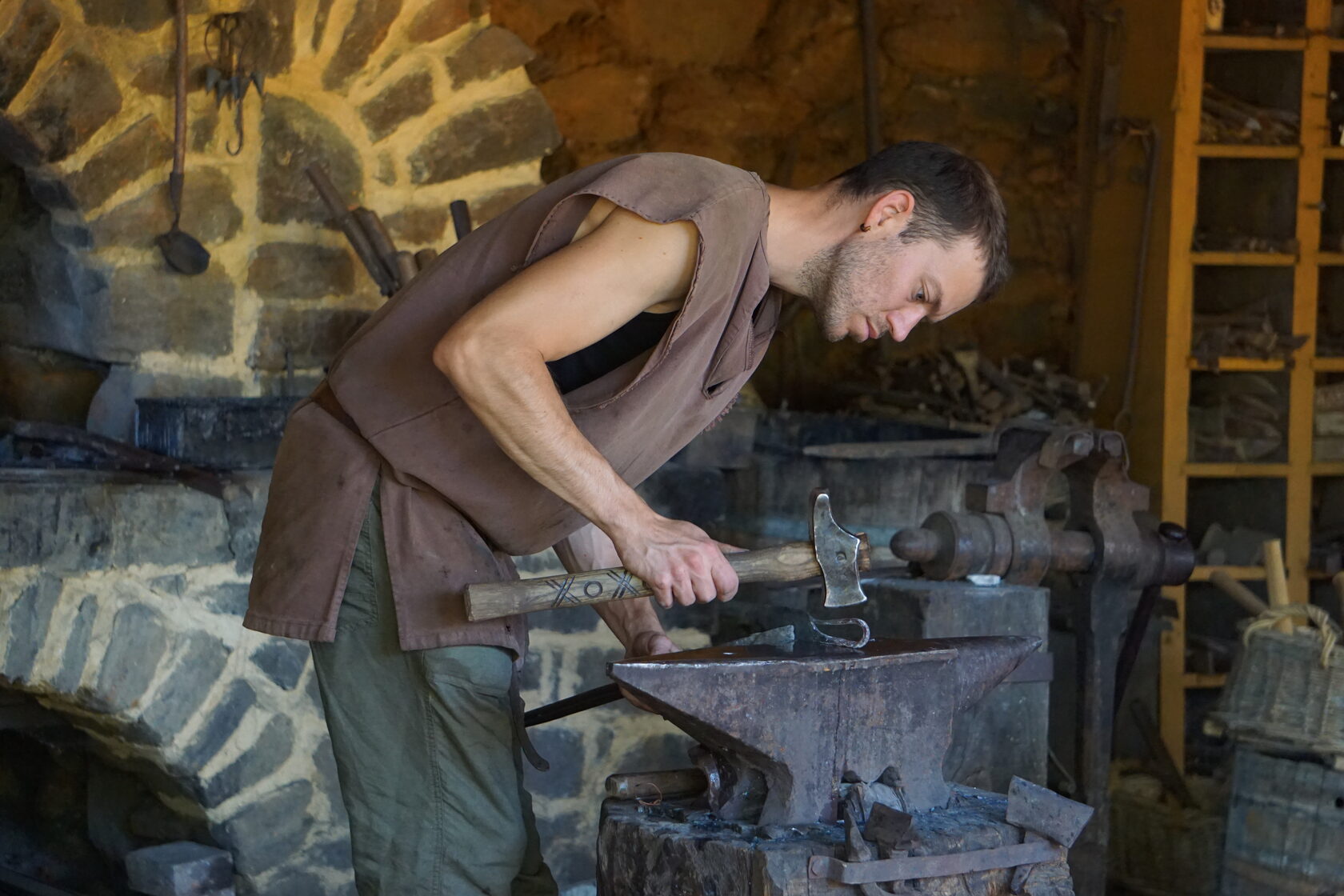
©Guédelon
CnP: Are you thinking about getting a ghost for your new castle – maybe you could resettle one from another chateau?
MM: We're probably the only castle in the world without a ghost!
CnP: What is more difficult and expensive – to restore a ruined castle or to build a new one from scratch?
MM: Building a vault from scratch is much, much easier than trying to restore one damaged by time.
MM: We're probably the only castle in the world without a ghost!
CnP: What is more difficult and expensive – to restore a ruined castle or to build a new one from scratch?
MM: Building a vault from scratch is much, much easier than trying to restore one damaged by time.

©Guédelon
CnP: What would you tell those who are dreaming about buying a castle for themselves to restore to former glory to live in or to make a hotel out of it?
MM: Guedelon is proof that dreams can come true. Follow your dreams!
MM: Guedelon is proof that dreams can come true. Follow your dreams!
We very much hope that you liked the interview with Maryline Martin, co-founder and CEO of Chateau de Guedelon.
Don't miss new stories by castle owners and hotel industry pros!
Photo credits: @Chateau de Guedelon
You can always get in touch with us via castlesandfamilies@gmail.com
Don't miss new stories by castle owners and hotel industry pros!
Photo credits: @Chateau de Guedelon
You can always get in touch with us via castlesandfamilies@gmail.com